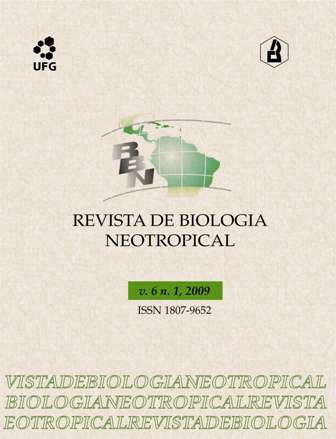Plant resources of Restinga de Carapebus , Rio de Janeiro, Brazil
DOI:
https://doi.org/10.5216/rbn.v6i1.12628Keywords:
Ethnobotany, Restinga de Jurubatiba National Park, economic potential, coastal sand plainsAbstract
The present paper aimed at identifying the plant resources used in the Restinga de Carapebus, Restinga de Jurubatiba National Park, Rio de Janeiro, Brazil. We carried out 13 one-week visits to the study area and the informants were nominated by the local population. For each species we present local name, category of use, local uses, and type of plant formation. We identified only one person in the Restinga de Carapebus who knows, uses, and indicates the plants of the coastal sand plains for several purposes. The informant indicated 119 species used, distributed in 100 genera and 49 families, and the most important families in number of species are Myrtaceae (10 species), Clusiaceae and Rubiaceae (both with 6 species). The plants used were classified into the following categories: food, medicine, ornamental, technology, hygiene, fragrance, construction, and firewood. The medicinal usage predominated, with 45 species, among which anti-diarrheic plants presented the highest number of species (10). Most useful species (67) occur in the open Clusia scrub formation. The results presented here are relevant to preserve the cultural use of plant resources in the Restinga de Carapebus.Downloads
References
Alexiades, M. N. 1996. Collecting ethnobotanical data: an introduction to basic concepts and techniques, p. 53-94. In: M. N. Alexiades (Ed.), Selected guidelines for ethnobotanical research: a field manual. Bronx, The New York Botanical Garden.
Amorozo, M. C. M. 1996. A abordagem etonobotânica na pesquisa de plantas medicinais, p. 47-68. In: L. C. Di Stasi (Org), Plantas medicinais: arte e ciência. Um guia de estudo interdisciplinar. São Paulo, Editora da Universidade Estadual Paulista.
APG II. 2003. An update of the Angiosperm Phylogeny Group classification for the orders and families of flowering plantas: APG II. Bot. Linnean Soc. 141: 399-436.
Araújo, D. S. D. 2000. Análise florística e fitogeográfica das restingas do Estado do Rio de Janeiro. Tese de Doutorado. Universidade Federal do Rio de Janeiro, Rio de Janeiro.
Araújo, D. S. D., A. F. Costa, A. S. Oliveira & R. L. Moura. 2001. Florística e padrões fitogeográficos, p. 155-165. In: A. F. Costa & I. C. A. Dias (Orgs), Flora do Parque Nacional da Restinga de Jurubatiba e arredores, Rio de Janeiro, Brasil: listagem, florística e fitogeografia: angiospermas, pteridófitas, algas continentais. Rio de Janeiro, Museu Nacional do Rio de Janeiro.
Araújo, D. S. D., F. R. Scarano, C. F. C. Sá, B. C. Kurtz, H. L. T. Zaluar, R. C. M. Montezuma & R. C. Oliveira. 1998. Comunidades vegetais do Parque Nacional da Restinga de Jurubatiba, p. 39-62. In: F. A. Esteves (Ed), Ecologia das lagoas costeiras do Parque Nacional da Restinga de Jurubatiba e do Município de Macaé, Rio de Janeiro. Rio de Janeiro, Universidade Federal do Rio de Janeiro.
Azevedo, V. M. 2008. Recursos vegetais utilizados pela comunidade quilombola de Machadinha, Quissamã-RJ. Dissertação de Mestrado. Universidade Federal do Rio de Janeiro, Rio de Janeiro, RJ.
Boscolo, O. H. & L. Senna-Valle 2008. Plantas de uso medicinal em Quissamã, Rio de Janeiro, Brasil. Iheringia 63: 263-277.
Fonseca-Kruel, V. S. & A. L. Peixoto. 2004. Etnobotânica na Reserva Extrativista Marinha de Arraial do Cabo, Brasil. Acta Bot. Bras. 18: 177-190.
Fonseca-Kruel, V. S., A. L. Peixoto, C. F. C. Sá, D. S. D. Araújo, W. L. Silva & A. J. Ferreira. 2006. Plantas úteis da restinga:
o saber dos pescadores artesanais de Arraial do Cabo, Rio de Janeiro. Instituto de Pesquisas Jardim Botânico do Rio de Janeiro, Rio de Janeiro, 36 p.
Fonseca-Kruel, V. S., D. S. D. Araújo, C. F. C. Sá & A. L. Peixoto. 2009. Quantitative ethnobotany of a restinga forest fragment in Rio de Janeiro, Brazil. Rodriguesia 60: 187-202.
Hernandez-Xolocotzi, E. 1983. El concepto de etnobotanica, p. 13-18. In: A. Barrera (Ed), La etnobotanica: tres puntos de vista y una perspectiva. Xalapa, Instituto Nacional de Investigaciones sobre Recursos Bióticos.
Kelecom, A., G. L. Reis, P. C. A. Fevereiro, J. G. Silva, M. G. Santos, C. B. M. Neto, M. S. Gonzáles, R. C. S. Gouvêa & G. S. S. Almeida. 2002. A multidisciplinary approach to the study of the fluminense vegetation. An. Acad. Bras. Cienc. 74: 171-181.
Kneip, L. M., D. S. D. Araújo & V. S. Fonseca. 1995. Áreas de exploração de recursos abióticos e bióticos das populações pré-históricas de Saquarema, RJ. Documento de Trabalho (Série Arqueologia) 3: 3-12.
Santos, M. G., P. C. A. Fevereiro, G. L. Reis, J. I. Barcelos & F. M. M. A. Ney. 2009. Plantas da restinga: potencial econômico. Technical Books Editora, Rio de Janeiro, 139 p.
Thomsom, W. A. R. 1981. Guía práctica ilustrada de las plantas medicinales. Editorial Blume, Barcelona, 220 p.
Downloads
Published
How to Cite
Issue
Section
License
The expontaneos submmition of the manuscript automaticaly implies in the cession of all patrimonial rights for the Journal of Neotropical Bilogy (RBN) after publication. The autor allow the right of first publication of the article to the RBN, under Creative Commons Attribution 4.0 (CC BY-NC 4.0) Licence.
There are garanties for the authors to the authorial and moral rights, for each one of the articles published by RBN, with permissions:
1. The use of article and contents for the education and researches.
2. The use of the article and their contents, linking to the Article on the web site of the RBN, allowing the divulgation on:
- institutional closed web (intranet).
- open access repositories.
3. Preparation and divulgation of the other publication derived from the article and its content, if there is citation of the original publication by RBN.
4. Make printed copies in small quatinties for personal use.

















